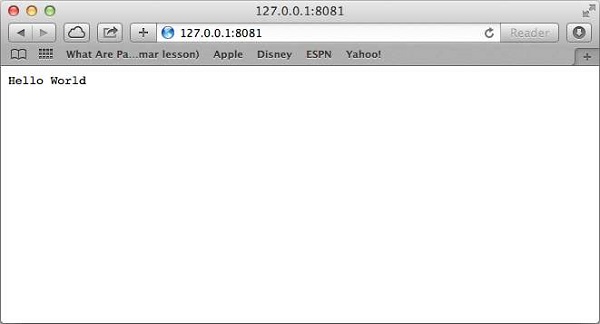Node.js-첫 번째 애플리케이션
실제 "Hello, World!"를 만들기 전에 Node.js를 사용하는 애플리케이션에서 Node.js 애플리케이션의 구성 요소를 살펴 보겠습니다. Node.js 애플리케이션은 다음 세 가지 중요한 구성 요소로 구성됩니다.
Import required modules − 우리는 require Node.js 모듈을로드하기위한 지시문.
Create server − Apache HTTP Server와 유사한 클라이언트의 요청을 수신하는 서버.
Read request and return response − 이전 단계에서 생성 된 서버는 브라우저 또는 콘솔이 될 수있는 클라이언트의 HTTP 요청을 읽고 응답을 반환합니다.
Node.js 애플리케이션 생성
1 단계-필수 모듈 가져 오기
우리는 require http 모듈을로드하고 반환 된 HTTP 인스턴스를 다음과 같이 http 변수에 저장하는 지시문-
var http = require("http");2 단계-서버 생성
생성 된 http 인스턴스를 사용하고 http.createServer() 방법을 사용하여 서버 인스턴스를 만든 다음 포트 8081에서 바인딩합니다. listen서버 인스턴스와 연관된 메소드. 매개 변수 요청 및 응답과 함께 함수를 전달하십시오. 항상 "Hello World"를 반환하도록 샘플 구현을 작성합니다.
http.createServer(function (request, response) {
// Send the HTTP header
// HTTP Status: 200 : OK
// Content Type: text/plain
response.writeHead(200, {'Content-Type': 'text/plain'});
// Send the response body as "Hello World"
response.end('Hello World\n');
}).listen(8081);
// Console will print the message
console.log('Server running at http://127.0.0.1:8081/');위의 코드는 수신 대기하는 HTTP 서버를 생성하기에 충분합니다. 즉, 로컬 시스템에서 8081 포트를 통한 요청을 기다립니다.
3 단계-요청 및 응답 테스트
1 단계와 2 단계를 파일에 함께 넣습니다. main.js 다음과 같이 HTTP 서버를 시작하십시오.
var http = require("http");
http.createServer(function (request, response) {
// Send the HTTP header
// HTTP Status: 200 : OK
// Content Type: text/plain
response.writeHead(200, {'Content-Type': 'text/plain'});
// Send the response body as "Hello World"
response.end('Hello World\n');
}).listen(8081);
// Console will print the message
console.log('Server running at http://127.0.0.1:8081/');이제 다음과 같이 main.js를 실행하여 서버를 시작하십시오.
$ node main.js출력을 확인하십시오. 서버가 시작되었습니다.
Server running at http://127.0.0.1:8081/Node.js 서버에 요청하기
브라우저에서 http://127.0.0.1:8081/을 열고 다음 결과를 관찰하십시오.

축하합니다. 포트 8081에서 모든 HTTP 요청에 응답하는 첫 번째 HTTP 서버가 실행 중입니다.